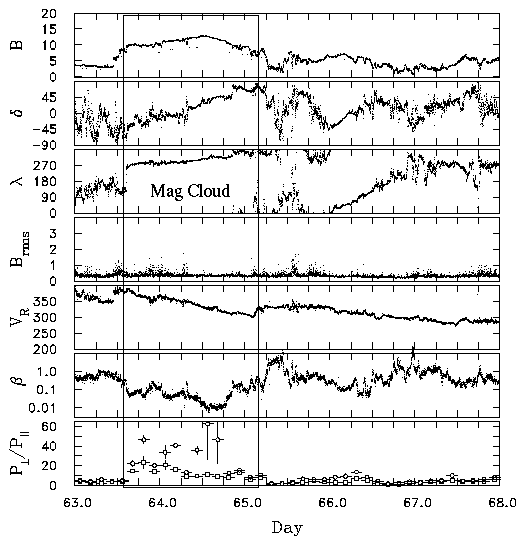
| ACE News Archives | ACE News #39 |
ACE News Archives |

Magnetic clouds are a frequently observed feature of the solar wind plasma seen by the ACE spacecraft at L1. They are large magnetic structures possessing 3 characteristics: the intensity of the magnetic field is high, the temperature of the ambient protons is low, and the field displays a smooth, large-scale rotation over the passage of the object. Most clouds are very large structures that pass over the spacecraft in a day or more. At 1 AU, this represents a large fraction of the Earth-to-Sun distance. Magnetic clouds evolve in relative isolation from the surrounding plasma, which explains at least in part their large-scale features. They exhibit flux rope characteristics: a large-scale winding of a closed magnetic structure that is nearly force-free.
The figure shows an example of a magnetic cloud observed by ACE in March 1998. Both MAG and SWEPAM data are shown. As the cloud passes over the spacecraft the magnetic field intensity (B) rises, the thermal ion temperature (beta) drops, and the magnetic field direction rotates smoothly in latitude (lambda) and longitude (delta).
At smaller spatial scales magnetic clouds appear to possess fluctuation characteristics that are remarkably different from the surrounding plasma: both the magnetic fluctuations and the associated wave vectors appear to be at larger angles to the mean magnetic field than is typical of interplanetary conditions. As the plasma temperature within the cloud drops the magnetic fluctuations become increasing perpendicular to the mean magnetic field. This can be seen in the bottom panel which is a plot of the ratio of magnetic fluctuation energies perpendicular and parallel to the mean field. Preliminary analyses indicate that the wave vectors also rotate to a more perpendicular orientation.
This behavior is interesting for two reasons: first, the evolution of the magnetic turbulence takes on a different form when the wave vectors are at large angles to the mean field; and, second, the fluctuations fall out of resonance with energetic particles. This means that a smaller fraction of the observed magnetic fluctuation energy will be available for scattering the energetic particles so that energetic solar particles should possess longer mean free paths within magnetic clouds.
The examination of the properties of magnetic turbulence within clouds and the associated scattering of energetic ions is ongoing by the ACE MAG, SWEPAM and EPAM teams.
Contributed by Charles Smith, Bartol Research Institute, University of Delaware.
See The MAG Home Page for more information on ACE MAG.
Last modified December 2, 1999, by
Andrew Davis